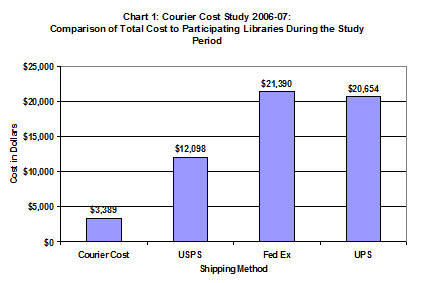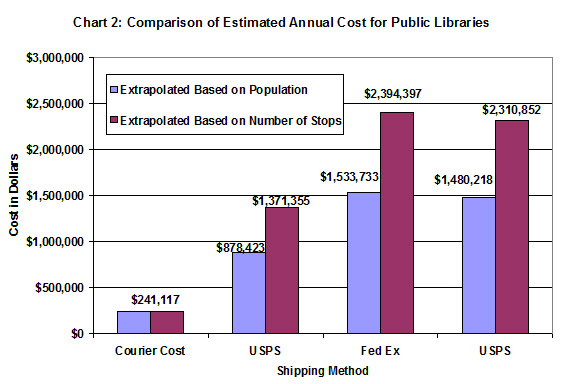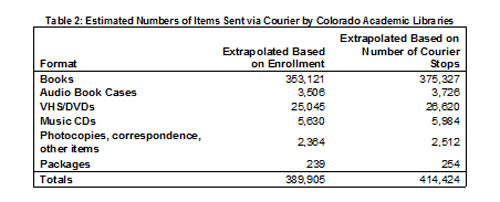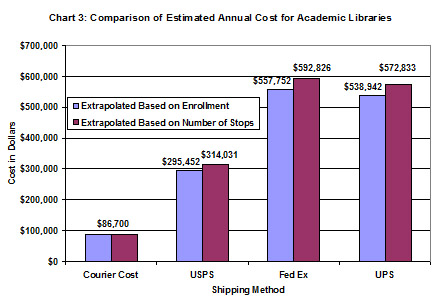During the months of October 2006 and February 2007, 27 public, academic, school, and special libraries in Colorado collected statistics on the number and format of items sent via the statewide courier service, operated by the Colorado Library Consortium (CLiC). The study was undertaken to determine the cost-effectiveness of the courier service.
Without the presence of a statewide courier, Colorado’s libraries would need to find alternative methods of transferring items between library systems—most likely they would need to ship materials using a standard shipping company, i.e., the U.S. Postal Service (USPS), Federal Express (FedEx), or United Parcel Service (UPS). For the purposes of this study, we collected data for items sent on the courier by the libraries, rather than received, because in using the standard shipping methods mentioned above the sender nearly always incurs the cost (COD being the exception). Statistics were collected during specified weeks in October and February—some libraries participated in data collection during only one of these periods, while others participated during both. Statistics for all libraries were annualized.
 Based on the data collected, the courier proved to be extremely cost-effective. During the study period, participating libraries were charged $3,389 for their participation in the courier. Estimates for the cost of sending materials via a shipping company were made using average weights for each type of item (e.g., books, DVDs, audio tapes). For each shipping company, the least expensive option within its services was chosen. The most economical alternative shipping method—USPS—was more than 3.5 times more expensive than the courier, at $12,098. Shipping the same materials via Federal Express or UPS would cost even more, with both of those services topping $20,000 (see Chart 1).
Based on the data collected, the courier proved to be extremely cost-effective. During the study period, participating libraries were charged $3,389 for their participation in the courier. Estimates for the cost of sending materials via a shipping company were made using average weights for each type of item (e.g., books, DVDs, audio tapes). For each shipping company, the least expensive option within its services was chosen. The most economical alternative shipping method—USPS—was more than 3.5 times more expensive than the courier, at $12,098. Shipping the same materials via Federal Express or UPS would cost even more, with both of those services topping $20,000 (see Chart 1).
Additionally, courier service is more convenient than standard shipping methods, and undoubtedly saves staff time and packaging costs. When using the courier, library staff place all courier-delivered items in a bin with a label directing courier staff how to route the item. For any of the alternative methods, items need to be more carefully packaged in boxes and protective wrapping. This savings of time and materials increases the courier’s cost-effectiveness even more.
Statewide Usage
There were too few participating school and special libraries to even attempt extrapolating their data on a statewide level, but participation from public and academic libraries was sufficient to attempt an estimate. This study had a relatively small number of participants, and they were a self-selected (volunteer) group, making it impossible to assume a representative sample and difficult to extrapolate numbers of items moved on a statewide level.
Making extrapolation even more difficult is the fact that different libraries use the courier in very different ways. For example, Grand County Library District, which serves a population of around 14,000 people, has the courier stop at all 6 of its locations, and uses the courier for intra-library loaning of items (materials sent between Grand County libraries), as well as inter-library loans (materials sent to other library systems). Meanwhile, Aurora Public Library, which serves nearly 300,000 people at its 7 branches, has the courier only stop at one location, and uses it only for inter-library loans. These two library systems, serving quite different populations, have very similar courier usage numbers.
This suggests that extrapolating exclusively on the basis of population served (or in the case of academic libraries, enrollment) or solely on number of courier stops may produce an inaccurate number. Because no single method recommends itself, extrapolations were made using both methods (see Table 1).
Using these estimations, it is expected that public libraries ship somewhere near 2 million items on the courier each year and save between $600,000 and $1 million annually, when comparing courier cost with USPS. Again, this savings jumps dramatically if the alternative shipping method were either FedEx or UPS (see Chart 2).
Extrapolated in the same manner, it is projected that academic libraries in Colorado ship around 400,000 items on the courier (see Table 2) and in the process save more than $200,000 over USPS costs, while spending less than $100,000 on courier service (see Chart 3).
It is highly probable that courier usage is increasing. Prospector, the unified catalog of 23 libraries in Colorado and Wyoming, which uses the courier as its shipping method, has seen a dramatic rise in use over the past few years. According to their statistics (found at http://www.coalliance.org), they fulfilled 129,719 requests between library systems in 2003. For 2006, that number nearly tripled, to 377,632. For the first three months of 2007, 116,546 requests were fulfilled; at that pace, Prospector will reach 466,184 requests fulfilled for the year. The courier is involved twice with each of those requests—once to move it to the requesting library, and again to return it to the owning library.
Again, given the diversity of the libraries on the courier, and the small, volunteer nature of the participating sample, these estimates are just that—estimates. Any number of factors could affect the true annual totals in either direction. For instance, the 2 largest public libraries in the state—Denver Public Library and Jefferson County Public Library—both participate heavily on the courier, moving large numbers of materials via Prospector. However, neither of them participated in this study, so their data could not be used to aid in the extrapolations.
Without a more comprehensive study, an exact number of items moved by the courier each year cannot be pinpointed. In addition to the problems inherent in attempting to extrapolate for public and academic libraries, insufficient data is available for school and special libraries as well as community courier stops to attempt an extrapolation. However, it is safe to say that millions of items are being sent among Colorado libraries each year using the statewide courier, and the savings provided to these libraries is tremendous. Combined public and academic libraries alone would spend over 250 percent more using USPS, the least expensive alternative.




